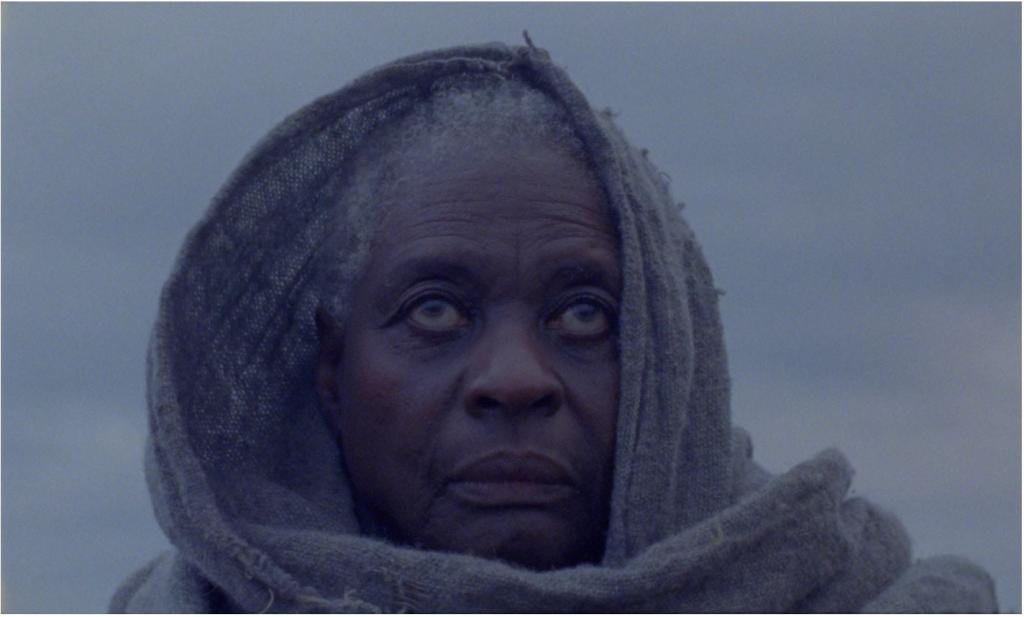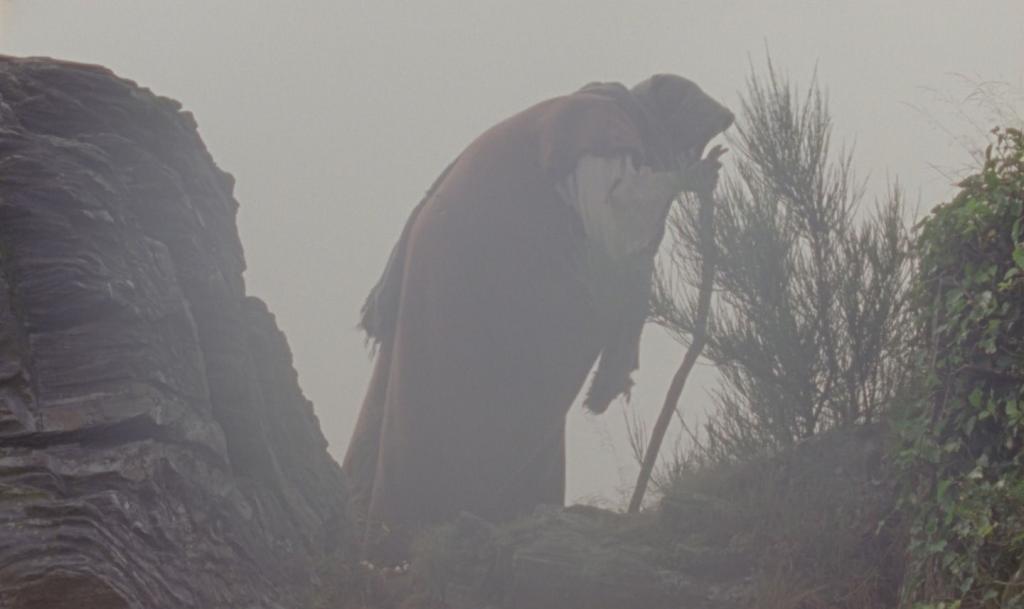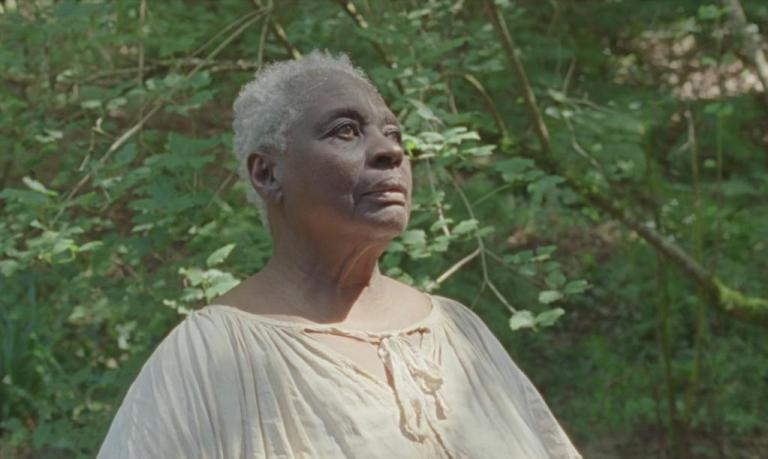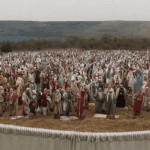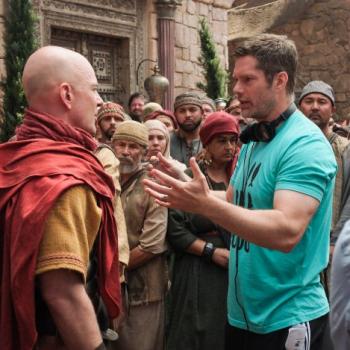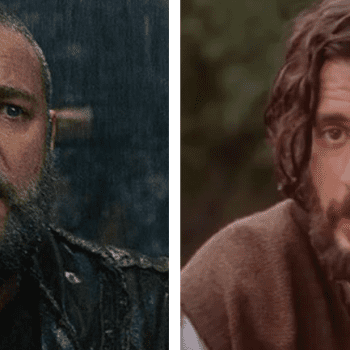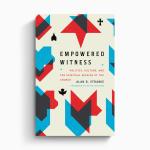The Cannes Film Festival came and went a few weeks ago, and with it, the world premiere of Damien Manivel’s Magdala, which played in the ACID (Association for the Distribution of Independent Cinema) sidebar to the festival.
I’ve been meaning to post some reviews of the film, which depicts Mary Magdalene living in isolation some years after the life of Jesus, but very few reviews have come my way. However, a few have trickled out, so take a look at them below.
Also: we have actual clips from the film!
First, the clips, courtesy of Cineuropa.
First, a woman with a candle approaches the sleeping Mary Magdalene in a cave:
Second, a man and a woman — Jesus and the young Mary Magdalene, presumably — look at each other and hold hands (note: there is some brief nudity here):
You can also see these clips on the ACID’s YouTube channel (Clip 1, Clip 2).
IndieWire, meanwhile, profiled the film’s cinematographer Mathieu Gaudet (the parts that jump out at me, I’m putting in italics):
“Magdala”
Dir: Damien Manivel, DoP: Mathieu Gaudet
Format: 16mm Kodak 500T
Camera: Aaton Xtera
Lens: Zeiss Super SpeedGaudet: At the beginning of the shooting preparation Damien told me he wanted us to have the impression that the footage of his movie had been found, buried somewhere in the forest where Magdala lived. Just like for the actress, who is an extraordinary dancer, capable of putting so much physical intensity in the smallest gesture, he was looking for something with a strong physical presence within the image itself. To follow up on this idea, we decided to shoot everything handheld and in long shots, to “humanize” the camera. That’s also what brings us to film. Because of its physicality and its fragility, it’s a bit like the movie has a body too. Damien was at first hesitating between film and DV. DV has also a kind of materiality, with the magnetic tape. We ran tests with both formats, on locations, making the shots Damien had in mind: 16mm was the obvious choice. The physicality of the support was very sensitive. It was also conveying, in a very simple way, a kind of sacredness to what we filmed. We also ran tests between the Kodak 500T and 250D film. We chose the 500T because there is more texture and we also needed its high sensitivity for the candle scenes. 16mm — instead of the 35mm — was also obvious, because the image had to feel humble, as is the character. Damien didn’t want to idealize his character too easily. That’s also why we finally chose, during color grading, not to add too much contrast or color saturation. I chose the Aaton Xtera because of its ergonomy, specially made for handheld shots. I knew it would be a great asset, because Damien wanted to do long lasting shots. And In the end, most of the shots took up the whole 12 minutes of the 16mm reels. I chose the Zeiss Super Speed because I like their aesthetic, they have a discreet softness that I find very simple and beautiful. It was also for practical reasons, because they are light and the 1.3 T-stop was very useful for the candle scenes.
And now, the reviews.
Rotten Tomatoes currently lists only one, from Amber Wilkinson at Screen Daily:
French director Damien Manivel’s quiet contemplation of the last days of Jesus’ disciple Mary Magdalene is built as much from the imagination of the viewer as it is by what he puts on the screen – he may show us what Mary is doing but it is us who must supply the thoughts that lie inside her head. This is a portrait of Mary (Elsa Wolliaston) in exile, following her retreat to an autumnal forest and, subsequently, a cave following the death of Christ, who Manivel indicates she loved, or at least aspired to love, in the physical sense as well as the emotional. . . .
Manivel’s main approach is to study Mary in the moment, whether it’s the delicate way she removes a blackberry from a bush, repeatedly fashions tiny crosses out of leaves and grass, or how she relieves her bladder while holding a tree for support. Wolliaston – who previously collaborated with Manivel on his short film The Lady With A Dog (2010) and his Locarno best director award-winning feature Isadora’s Children (2019) – has a dance and choreography background and brings a grace to Mary’s movements, even as we can see she is also struggling with ageing. . . .
The director periodically also allows more mystical elements to intrude, including memories of a different sun-dappled forest, filled with the heat of youthful desire, along with more anguished recollections of Christ, as Mary recalls his nailed feet. The mood of melancholy is enhanced by the autumnal setting, at one point shrouding Mary in mist, and two pieces of music. One, Franz Schubert’s ‘The Hurdy-Gurdy Man’, whose lyrics speak of an ageing soul and his instrument, the other Henry Purcell’s wistfully mournful ‘O Solitude, My Sweetest Choice’, both speaking to a sort of paradoxical comfort in loneliness.
Blake Williams at Filmmaker Magazine writes:
I was introduced to the work of French filmmaker Damien Manivel when his lovely Le Parc screened in Cannes’s ACID sidebar in 2016, and checked in with him there again for Magdala. The 78-minute film is an imagined portrait of Mary Magdalene shortly after the death of Jesus, and is a throwback to aughts-era slow cinema rigor. The conservatively color-graded 16mm cinematography was transferred to digital sans matting (i.e. the edges are rounded and feathered, sprockets vaguely visible), as Manivel goes all in on the elemental minimalism of early Lisandro Alonso and Albert Serra (viz. La Libertad [2001] and Birdsong [2008], respectively). Until she cries to heavens, “My love, my love…”, the film envelops the viewer in a score of rustling leaves, snapping twigs and the occasional breeze as Magdalena methodically crawls, walks, pees and weeps her way through a forest, encouraging us to consider the pointedly profane materiality of her image, situation, and environment.
Moments of abstraction peak in, such as a cutaway to Jesus’s bloody, staked feet, or another to Magdalena literally ripping out her own heart, but these exceptions are metaphors for the trauma absorbing her imagination; this is, in every essential way, an image-forward movie. Manivel is well aware that the action onscreen is held together by popular familiarity with Christian narratives—the religion’s mythology and iconography does all of the heavy lifting—and flirts with the limits of content and context in Magdala’s construction. Like the first filmed Passion Plays that helped usher narrative logic into cinema during its early years (e.g. the Lumière brothers’ La Passion [1897]), Magdala pushes information to the margins, and asks if an image can simply be an image. When Magdalena idly uses her walking stick to etch a portrait that I quickly recognized to be Jesus into the ground, my own act of inserting information into an image that gave very little of it—completing it, imposing upon it, with memories of other images of Him I’ve encountered in the past—became palpable in ways I’ve rarely felt in movies, and that’s not nothing.
Fabien Lemercier at Cineuropa writes:
Sometimes words don’t mean anything, and actually, they did not even exist in the early days of cinema. It is in this raw essence of the image and the body which lives in the heart of a deep forest, embraced by the sounds of nature, that Damien Manivel decided to immerse the well-known dancer and choreographer Elsa Wolliaston in Magdala. . . .
Filming the quintessence in its most radical austerity requires two components: a charismatic subject mastering every small body inflection (which the incredible Elsa Wolliaston does) and a director like Damien Manivel, who has great sensitivity and looks for strong creativity in simple elements. It makes for a mystic and sensory experience and becomes an ode to nature and art that cultivates open minds and nature lovers.
Michael Sicinski at In Review writes:
Magdala is a meditative film, proffering only the broadest outline of narrative information. That’s partly because Manivel is operating in the mythic register. This film observes the agonized final days on earth of Mary Magdalene, played by veteran actress Elsa Wolliaston in a bracingly physical performance. For much of the film, Magdala is hunched over and hobbling through a wooded thicket beside a stream, bearing herself along with a walking stick and soothing her parched lips with rainwater dropping off of leaves. At various moments, her survivalist resolve breaks down, and she curls up in anguish as she mourns for the lover she has, in a sense, outlived, but who of course is ever-present. . . .
The film is attractively shot by Mathieu Gaudet, and the images often lend Wolliaston’s skin a verdant tone, as if she were less a human being than an extension of the surrounding landscape which, under the circumstances, we’re asked to recognize as God’s creation. . . .
But when it comes to the cinema of longueurs, editing is paramount. Manivel assembled Magdala himself, and at times there is a lack of clear motivation for one image following another. Also, although the final act may be preordained in some respect, it is protracted without achieving the desired rhythm or mood. Magdala almost signals this sense by ending on a strikingly literal note, a move very much at odds with the atmospheric film that we’ve just watched.
Finally, there is this video review from Ryan Coleman via UniFrance, who found the film “moving” and also makes an interesting comment about the film’s ending:
Last but not least, some new photos, courtesy of ACID and UniFrance:
There is also one photo of Jesus and Mary lying naked in the grass together, which I won’t post here in case anyone finds it offensive. But you can see it at the sites linked above.
Also, IndieWire posted this behind-the-scenes shot with their profile of Gaudet:
The film is reportedly opening in French theatres July 20, which happens to be two days before Mary Magdalene’s feast day in the Orthodox and Catholic churches. I’ll be keeping my ears open for any North American screenings. If you hear anything, please let me know (whether in the comments below or via my public social-media accounts).


